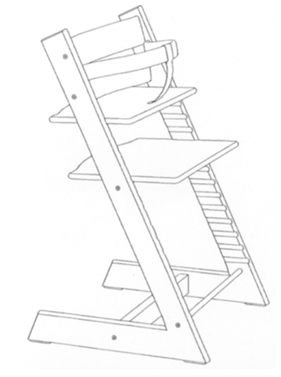Noot Charles Gielen onder Hauck - Stokke
Charles Gielen, Noot onder HvJ 18 sept 2014 Hauck/Stokke, IEF 15328; eerder in NJ.

 Bijdrage ingezonden door Charles Gielen, NautaDutilh en RUG. 1. De bescherming van vormen van producten als merk blijft aanleiding geven tot steeds nieuwe rechtspraak. De hier besproken zaak is er weer een mooi voorbeeld van. Het wordt ondernemers die voor vormen van producten merkbescherming willen, niet gemakkelijk gemaakt. Dat komt in de eerste plaats doordat het Europese Hof van oordeel is dat het voor consumenten lastiger is aan de hand van de vorm de herkomst van producten te onderscheiden (zie recent nog HvJ 10 juli 2014, NJ 2015/283, Apple Store met mijn noot en de in dat arrest aangehaalde oudere rechtspraak). Daarom, zo vindt het Hof, kunnen alleen die vormen, die significant afwijken van de norm in de markt als onderscheidend worden gezien en dus merk zijn. Maar als een ondernemer (zoals in dit geval Stokke) erin is geslaagd de rechter ervan te overtuigen dat de vorm van zijn product als merk fungeert, komt de volgende horde.
Bijdrage ingezonden door Charles Gielen, NautaDutilh en RUG. 1. De bescherming van vormen van producten als merk blijft aanleiding geven tot steeds nieuwe rechtspraak. De hier besproken zaak is er weer een mooi voorbeeld van. Het wordt ondernemers die voor vormen van producten merkbescherming willen, niet gemakkelijk gemaakt. Dat komt in de eerste plaats doordat het Europese Hof van oordeel is dat het voor consumenten lastiger is aan de hand van de vorm de herkomst van producten te onderscheiden (zie recent nog HvJ 10 juli 2014, NJ 2015/283, Apple Store met mijn noot en de in dat arrest aangehaalde oudere rechtspraak). Daarom, zo vindt het Hof, kunnen alleen die vormen, die significant afwijken van de norm in de markt als onderscheidend worden gezien en dus merk zijn. Maar als een ondernemer (zoals in dit geval Stokke) erin is geslaagd de rechter ervan te overtuigen dat de vorm van zijn product als merk fungeert, komt de volgende horde.
Bepaald is namelijk (zie art. 3(1)(e) Merkenrichtlijn en in navolging art. 2.1(2) BVIE) dat niet als merk kunnen worden ingeschreven tekens die uitsluitend bestaan uit (i) de vorm die door de aard van de waar wordt bepaald, (ii) de vorm van de waar die noodzakelijk is om een technische uitkomst te verkrijgen en (iii) de vorm die een wezenlijke waarde aan de waar geeft. Over de betekenis van die uitzonderingen onder Europees recht bestond lange tijd onzekerheid. Onder het Benelux merkenrecht, zoals dat gold vóór de aanpassingen aan de Europese Harmonisatierichtlijn Merkenrecht bestonden die uitzonderingen ook al. Inmiddels heeft het Hof over alle drie uitzonderingen beslist en we weten nu dat de uitleg van die uitzonderingen aanzienlijk beperkter is dan voorheen. De uitzondering onder (iii), technische uitkomst, is door het Hof uitgelegd in de zaken Philips/Remington (HvJ 18 juni 2002, NJ 2003/481) en Lego/Megabrands (HvJ 14 sept. 2010, BIE 2010/94, p. 408). Het hier besproken arrest geeft uitleg aan (i) aard van de waar, en (ii) wezenlijke waarde van de waar.
(...)
10. Gevreesd moet worden dat met name de toepassing van de op zich al onduidelijke uitzondering van de wezenlijke waarde van de waar er niet veel duidelijker op is geworden. Het zal door de vaagheid van de elementen waarmee rekening gehouden moet worden, en de onderlinge samenhang daarvan in de praktijk, leiden tot meer geschillen waar niemand op zich te wachten. Mede gelet op de eveneens niet overtuigende grondslag van deze uitzondering is het de vraag of deze uitzondering maar niet beter kan worden afgeschaft, waarvoor ik elders heb gepleit (zie Hoyng-bundel (2013), p. 178 e.v.; zie ook EIPR 2014, 164). Daar gaf ik ook aan dat het opvallend is dat in het Amerikaanse merkenrecht ten aanzien van een soortgelijke easthetic functionality-doctrine brede kritiek bestaat. Ondanks het voorstel van het Max Planck Instituut aan de Europese Commissie om de uitzondering af te schaffen althans niet toepasselijk te achten wanneer het vormmerk als merk is ingeburgerd, wordt de uitzondering blijkens de laatste en waarschijnlijk definitieve tekst van de voorgesteld herziening van de Merken Verordening en Merken Richtlijn gehandhaafd, en zelfs uitgebreid. In de toekomst zal niet alleen de vorm van de waar die een wezenlijke waarde daaraan geeft, worden uitgesloten, maar ook andere kenmerken van de waar. Kortom: het laatste woord is niet gesproken! Tenslotte: het arrest is ook geannoteerd door A. Kur (GRUR 2014, p. 1099), M.F.J. Haak (BIE 2015/11, p. 65) en J.C.S. Pinckaers (IER 2015/24, p. 176).
 Bijdrage ingezonden door Charles Gielen,
Bijdrage ingezonden door Charles Gielen,  Contractsovername merklicentie, akte-vereiste van art. 6:159 BW. Eiser is houder van het beeldmerk
Contractsovername merklicentie, akte-vereiste van art. 6:159 BW. Eiser is houder van het beeldmerk  Met samenvatting van Bas Kist of Volkert Teding van Berkhout,
Met samenvatting van Bas Kist of Volkert Teding van Berkhout, 
 Merkenrecht. Beschikking. Pacogi heeft een Benelux-
Merkenrecht. Beschikking. Pacogi heeft een Benelux- Merkenrecht. Bihol en Qualiphar zijn ondernemingen die zich bezighouden met de ontwikkeling, productie en verkoop van voorschriftvrije geneesmiddelen en gezondheidsmiddelen. Bihol stelt dat Qualiphar in strijd met de overeenkomst producten met de merken BIOROPA en OSTRIN buiten de Benelux aanbiedt en de merken in Frankrijk, Turkijke en Cyprus heeft geregistreerd. De rechtbank wees de vorderingen af. Het beroep van Bihol is zonder succes. Qualiphar kan niet aansprakelijk worden gehouden voor de wederverkoop van haar contractproducten door afnemers buiten de Benelux en op internet. Daarnaast zijn Qualiphar en Gifrer afzonderlijke vennootschappen en kan niet worden aangetoond dat Gifrer contractproducten van Qualiphar verkoopt of dat Qualiphar producten op haar website aanbiedt. De grieven falen.
Merkenrecht. Bihol en Qualiphar zijn ondernemingen die zich bezighouden met de ontwikkeling, productie en verkoop van voorschriftvrije geneesmiddelen en gezondheidsmiddelen. Bihol stelt dat Qualiphar in strijd met de overeenkomst producten met de merken BIOROPA en OSTRIN buiten de Benelux aanbiedt en de merken in Frankrijk, Turkijke en Cyprus heeft geregistreerd. De rechtbank wees de vorderingen af. Het beroep van Bihol is zonder succes. Qualiphar kan niet aansprakelijk worden gehouden voor de wederverkoop van haar contractproducten door afnemers buiten de Benelux en op internet. Daarnaast zijn Qualiphar en Gifrer afzonderlijke vennootschappen en kan niet worden aangetoond dat Gifrer contractproducten van Qualiphar verkoopt of dat Qualiphar producten op haar website aanbiedt. De grieven falen. Bijdrage ingezonden door Antoon Quaedvlieg,
Bijdrage ingezonden door Antoon Quaedvlieg,  Merkenrecht. Carsten Bopp heeft een gemeenschapsmerkaanvraag gedaan. Ook volgens de kamer van beroep is de achthoekige vorm een eenvoudige geometrische vorm, gebruikelijk voor etiketten. De kamer van beroep merkte op dat verzoekster het teken zelf in de beschrijving als een "kader" van andere items noemde. Het beroep wordt verworpen.
Merkenrecht. Carsten Bopp heeft een gemeenschapsmerkaanvraag gedaan. Ook volgens de kamer van beroep is de achthoekige vorm een eenvoudige geometrische vorm, gebruikelijk voor etiketten. De kamer van beroep merkte op dat verzoekster het teken zelf in de beschrijving als een "kader" van andere items noemde. Het beroep wordt verworpen.



























































































